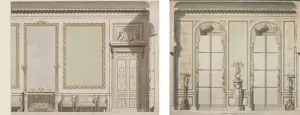Pierre Gouthière and the Duchess of Mazarin
Several of Gouthière’s masterpieces were commissioned by Louise-Jeanne de Durfort, the Duchess of Mazarin. An enthusiastic and faithful client, the duchess was the daughter-in-law of the Duke of Aumont and heiress to the vast Mazarin fortune. Most of the objects made for her — including the side table in blue turquin marble, the pair of wall lights with poppies, and the pair of firedogs with eagles on display in the exhibition — were intended for the gallery-salon of her townhouse, or hôtel particulier (since destroyed and now the site of the École des Beaux-Arts), on the Quai Malaquais in Paris.
The duchess initiated the renovation of the salon in 1778. The design was entrusted to the architect François-Joseph Bélanger, who delegated oversight of the work to the architect Jean-François-Thérèse Chalgrin. Gouthière was hired to put the finishing touches on these sumptuous interiors.
Extending across the building from courtyard to garden, each side of this long salon was to have at its center an element made of blue turquin marble, supplied and carved by the marblecutter Jacques Adan and decorated with gilt bronzes by Gouthière. On one long side, placed under a mirrored overmantel, was the blue turquin marble table; opposite was a chimneypiece decorated with satyresses. On the shorter sides, between windows, were two pedestals, each topped with a large candelabrum. The table and the chimneypiece were originally to be flanked by Gobelins tapestries, four panels in total, drawn from the Theatrical Scenes, made after cartoons by Charles Coypel (illustrated here).
What should have been a godsend for Gouthière became a nightmare because the Duchess of Mazarin was not timely in paying her bills. Her death, on March 17, 1781, left Gouthière with two outstanding invoices he assessed at 101,000 livres, an enormous sum considering that the hôtel particulier itself was sold for 420,000 livres. Six years later, when Gouthière was forced to surrender his assets to his creditors, he estimated the total of his invoices for work supplied but not yet paid for at 97,243 livres, of which he had only received 12,000 livres from the duchess or her estate.
Jean-Démosthène Dugourc (François-Joseph Bélanger’s architectural firm), Project for the gallery-salon of the Duchess of Mazarin’s hôtel particulier, showing the wall with the chimneypiece and the location of two of the four panels of Gobelins tapestry commissioned in 1771 but not installed until 1776 (the chimneypiece does not correspond to the model commissioned in 1780), ca. 1777. Ink and watercolor on paper, 16 3⁄ 8 x 20 7⁄ 8 in. Victoria and Albert Museum, London (above left)
Jean-Démosthène Dugourc, Project for the gallery-salon of the Duchess of Mazarin’s hôtel particulier showing the wall between the windows with two candelabra and a clock on a pedestal (the pedestal does not correspond to the model commissioned in 1780), 1777. Ink and watercolor on paper, 16 3⁄ 8 x 18 in. Private collection (above right)
Pair of Wall Lights, ca. 1780
Pierre Gouthière (1732–1813)
After a design by François-Joseph Bélanger (1744–1818)
Gilt and patinated bronze
Musée du Louvre, Paris; gift of the Société des Amis du Louvre, 2002
These wall lights were intended for the large gallery-salon of the Duchess of Mazarin’s hôtel particulier. From at least the mid-1770s, Gouthière had been proposing two sizes (small and large) of poppy wall lights to his clients. However, these differ from the other models by the extreme richness of the poppy branches with numerous flowers, almost every one distinct, features that increased both the time and cost of making the lights. Some of the flowers are only buds while others are fully opened to form the candle holders.
Side Table, 1781
Gilt bronze by Pierre Gouthière (1732–1813)
Marble supplied and carved by Jacques Adan
After a design by Jean-François-Thérèse Chalgrin (1739–1811) working under François-Joseph Bélanger (1744–1818)
Blue turquin marble and gilt bronze
The Frick Collection, New York; Henry Clay Frick Bequest
This table was in the workshop of Gouthière (with the gilding yet to be completed), when the Duchess of Mazarin died on March 17, 1781. What subsequently happened to it and for whom Gouthière finished it is not known, but it remains one of the artist’s masterpieces. The mask at the center of the entablature is one of the most beautiful faces ever created in gilt bronze.
Pair of Firedogs, 1781
Pierre Gouthière (1732–1813)
Modeled by Philippe-Laurent Roland (1746–1816) after a design by François-Joseph Bélanger (1744–1818)
Gilt bronze
Mobilier National, Paris
Two renowned sculptors worked in collaboration with Gouthière on the fireplace for the large salon of the Duchess of Mazarin’s hôtel particulier on Quai Malaquais. For the firedogs, Philippe-Laurent Roland modeled the two eagles of Jupiter — with their wings outspread and each holding a thunderbolt and a salamander — before the groups were chased and gilded by Gouthière. For the chimneypiece (now lost), Jean-Joseph Foucou modeled the two large figures of satyresses, which were then chased and fully gilded by Gouthière.




